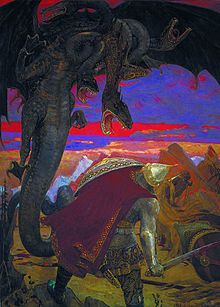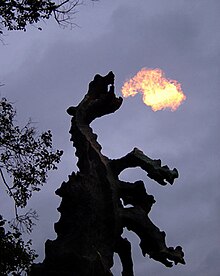Slavic dragon
The Slav dragon is the equivalent of the classic European dragon in Slavic mythology . His name there is Smei ( Duden romanization ) or Zmej ( Змей ) in Russian and Bulgarian , Zmij in Old Church Slavonic and Ukrainian , Żmij in Old Polish and Zmaj (Змај) in Bosnian , Serbian , Croatian and Slovenian . In the current Polish language and Belarusian the word is further Smok (Смок) used in the Bulgarian snakes called, and in Romania is known a similar creature called Zmeu .
etymology
Most of the above names are the masculine forms of the Slavic term for " snake " (Russian. Змея , Bulgar . Змия , Serb. And Croat . Zmija , Polish. Żmija ), and this is how Old Slavic mythology sees air-dwelling and fire spouting male dragon (Żmij) as a counterpart of the female dragon (Żmija) that lives underground and controls the water - a flourishing of vegetation and harvest is therefore only possible with harmony or reconciliation of both, the common image of living in caves, nevertheless fire-breathing dragons, on the other hand, the obvious attempt to bridge the (apparent) contradiction of both symbols.
The creature in the East Slavic area
Russia and Ukraine know the dragon as Smei / Smij Gorynytsch ( Змей Горыныч ). It is three-headed and green, walks on its two hind legs, has rather small front legs and can spit fire. According to an epic, Zmei Gorynytsch was defeated and killed by Dobrynja Nikitich .
Other Russian dragons, such as the Tugarin Smejewitsch, have Turkic names - perhaps based on the Mongols . So is St. George (a symbol of Christianity ) that the dragon as a symbol of Satan kills, on the Moscow coat of arms displayed. Some prehistoric buildings, especially the Serpent Wall near Kiev , were associated with the dragons as symbols of foreign peoples.
The creature in the South Slavic area

In Slovenia the dragon is called Zmaj , although an older word of unclear origin, Pozoj , can be used. Dragons are usually located in the malicious realm in Slovenia, and they are mostly depicted with St. George.
There are stories from pre-Christian times about dragons that were conquered in a similar way to the Polish Wawel dragon , for example , which was conquered with the help of a sulfur-filled lamb. Dragons are not always hostile to humans, however. For example, the Ljubljanski Zmaj (Ljubljana Dragon) protects the city of Ljubljana and is therefore depicted on the city's coat of arms.
In Macedonia , Croatia , Bulgaria , Bosnia , Serbia and Montenegro , the dragon ( Zmaj , Zmej or Lamja ) has many heads (three, seven or nine heads) and breathes fire. In Serbia, Bulgaria and Bosnia it is called Aždaja (Аждаја) or Ala (Ала). The Romanian word for dragon, zmeu , was most likely taken from Bulgarian.
The creature in the West Slavic area
In Poland , the Wawel Dragon , which is said to have lived in the Smocza Jama under Wawel Hill in Krakow , was killed by the legendary Krak , the founder of Krakow.
The dragon was a good animal among the Sorbs . It was called plon and as a money dragon could unexpectedly bring wealth into the house if it was fed enough millet gruel.
The saga of the money kite was spread to the far west of the former area of the surbi . The wife of the former mayor, Barbara Meyhe , who was accused of witchcraft in Bernburg an der Saale in 1617 , was embarrassedly asked whether she had a money kite that spewed money out on the pear tree in the garden.
According to mythology, there were four dragons in Dresden alone in the Elbe Sorbs :
- The dragon Meix in the Meixgrund .
- The Trachau dragon in the Trachenberge dragon gorge .
- The ice worm in the ice worm camp of the Plauen reason .
- The Lindwurm in the Nesselgrund of Klotzsche . This was an ancient cattle, not a pet, and every week devoured three young, beautiful girls from Klotzsche (he spat out old ones again), drank up the Prießnitz (which is why it still has little water today) and was therefore not only killed, but exterminated. No new dragon settled again because the remains of the old one still pollute the Stinkbach valley.
See also
Web links
Remarks
- ↑ Money dragon - cherishing millet porridge brings money blessings. The dragon is also a good animal for the Sorbs, as long as it is fed enough millet porridge. Then as plon, the money dragon, he unexpectedly brings wealth into the house. In: “ Legends and myths - about snakes, dragons and borrowed things ” on the website “sorbe.de” ( The Sorbs, Spreewald and Lusatia ), (accessed on January 25, 2020).
- ↑ See article Drachenschlucht in Stadtwiki Dresden (accessed January 25, 2020).
- ↑ See article Am Eiswurmlager in Stadtwiki Dresden (accessed January 25, 2020).
- ↑ See article Nesselgrundweg in Stadtwiki Dresden (accessed January 25, 2020).
- ↑ The Klotzscher Heideblatt. Independent local newspaper , 10th edition, II quarter 2000, p. 7.




